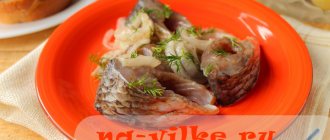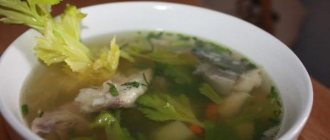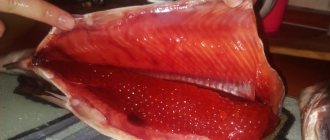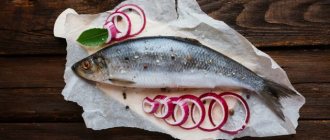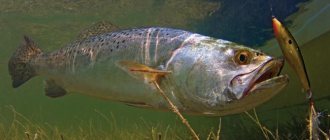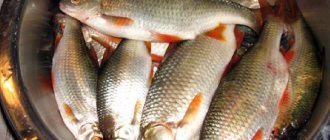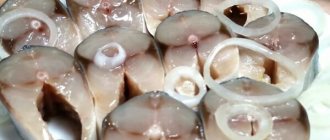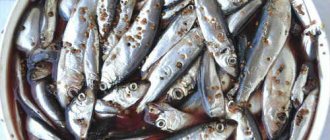Wet pickling
Dishes for wet salting fish should not oxidize.
This can be a glass or plastic container: a tank, a saucepan, a bucket, etc. Containers made of technical plastic are not suitable. Carp are placed in a container with their bellies up, sprinkled with salt at the rate of 1 kg of salt per 10 kg of fish. Salt can be mixed with a tablespoon of sugar to make the taste of the fish more delicate. A wooden circle is placed on the fish, and a weight is placed on it. You can use a flat plate, a lid from a pan, etc. as a lid. A brine begins to form in the container, and after one or two days it completely covers the fish carcasses. There is another way to salt carp using the wet method. Prepare brine from water and salt, pour this brine over the carcasses, cover the top with a lid and set the pressure. This option is better suited for smaller fish than for large carp.
Salting carp
Many people love salted fish. There is always a special demand for dried fish on store shelves. But you can salt carp at home simply and quickly. There are several options for pickling, and we will look at the most popular ones.
Salting methods
You can salt the carp according to one of the following recipes:
- Dry salting. Carp carcasses of small weight, about 150 g, are suitable for it. The fish is thoroughly rubbed with dry salt and placed in layers in a dish. Each layer is sprinkled with salt, and a weight is placed on top.
- Salting in a warm way. It is carried out similarly to dry salting. For this option, only freshly caught carp is suitable. The carcasses rubbed with salt are placed in a deep enamel bowl, a weight is placed and sent to the refrigerator for 2 - 5 days depending on the size
- Cold way. It differs from warm only in that the fish in the recipe is taken frozen.
- Mixed. In this case, the carcasses are first rubbed with salt, placed in a bowl and filled with salt solution. The cooked fish in this recipe has an unusually delicate taste.
To properly salt carp at home, you need to know how to prepare the fish for salting.
Large carp can be cut into pieces for salting. Small ones - salt whole. Large specimens are cut along the back and opened, separating the bones from one half (they are cut off from the ridge).
To increase the shelf life of fish, you do not need to gut or cut it. It is recommended to salt this one whole. The time spent under pressure depends on the size of the fish.
Salted carp
For salting you will need freshly caught fish. It is washed under running water, then the moisture is removed with a napkin. Salt is taken at the rate of 10-14% of the mass of the carp.
Whole carcasses are rubbed with salt and placed in a suitable container. They are placed under oppression for 2 days. After this time, the fish is washed. Gutted fish are rubbed with salt not only outside, but also inside.
When salting gutted carcasses, salt is also added to the abdominal cavity.
How do you know if you have enough salt? Carps kept under pressure are placed in a deep basin of water. If there is enough salt, the carcasses will float to the top.
If they still remain at the bottom of the basin, then it is necessary to soak the carp so as not to end up with an overly salty product. During the soaking process, the water will need to be changed several times.
After the carcass, lightly dry it with a towel and hang it to dry. Fish salted in this way can be stored for several months. For storage you will need a dry, well-ventilated place.
Pickling
Marinated carp is tasty and healthy. This dish is easy to prepare. It will take quite a lot of time. But the result is worth it. The following products are needed for marinating:
- a piece of fish weighing approximately 1 kg;
- salt -10 tbsp. l.;
- sugar – 4 tbsp. l.;
- half an orange and a lemon;
- ginger root;
- onion – 1 pc.;
- soy sauce;
- oil;
- greenery.
- We wash a piece of carp from the central part and let it dry.
- We spread cling film on the table.
- Mix sugar and salt. Sprinkle the film with this mixture and place the fish on it.
- Now you need to salt the carp. You can put a slice of lemon in the meat.
- Wrap it in film and send it to a cool place for 2 days.
- Unwrap the salted piece and rinse. Soak in water for 3-4 hours.
- In a separate container, prepare a mixture of finely chopped onion, soy sauce, oil, and grated ginger.
- Squeeze the juice from citrus fruits and add it to our sauce.
- Rub the carp pieces thoroughly with this marinade.
- Leave to marinate for half an hour in a cool place or refrigerator.
This dish is not suitable for long-term storage. Marinated carp can be served with a side dish of potatoes or cereals. A light vegetable salad is considered a good addition to fish treats.
How to salt carp
There are several ways to salt carp fish: let's look at them in more detail.
How to dry-salt carp: recipe with red pepper
Ingredients
- Carps (whole or pieces);
- Coarse salt – 200 g per 1 kg of fish;
- Red pepper.
Salting process
Before you start salting, gut the fish according to the above rules and dry it with paper towels, avoiding damage to the film on the belly.
If we cook fish to eat right away, be sure to cut it into pieces; in this case, before serving, you won’t have to bother with slicing.
Next we do the following:
- Rub the carcasses with salt on the outside and sprinkle on the inside.
- Place the fish in layers in an enamel pan, sprinkling with salt and pepper.
- Pour the remaining salt on top and cover with a dish or non-resinous wooden mug. Place a weight on top: a washed stone or a two-liter jar of water will do.
- Place the pan in a cool place for 12 hours until the brine appears.
- We put the pan in the refrigerator for 3-4 days - for fish weighing 0.5-1 kg. If you salt small fish, it will be ready in a couple of days.
Remove the weight, rinse the fish with cold water and serve with onions and herbs or a side dish.
How to salt carp with dry salting: method 2
This salting method can be used if the catch is decent. A piece of canvas or a box will help you store up to 10 kg of fish.
Ingredients
- Carps;
- Salt – 150 g per 1 kg of fish;
- Spices (black and allspice, coriander);
- Bay leaf.
How to salt carp at home
We prepare a piece of canvas or burlap and a basket (wooden box). Then we begin the salting process:
- Spread the fabric at the bottom of the basket or box.
- We place the gutted carp in a “jack” pattern on the fabric, sprinkling each row with spices and salt (the last row too).
- We place a wooden circle or ceramic dish on the carp, and a weight on top of it.
The load is necessary so that no air space is formed between the fish, in which bacteria develop, leading to spoilage of the product. In addition, with a load, the carp meat becomes denser.
The last step: put the basket of fish in the cellar or refrigerator for 4-5 days so that it is well salted. You can store fish in this condition for up to a month.
Salting
The most delicious salted bream, roach, sabrefish, ide, ram, vimba, bleak, pike perch, asp, catfish, taimen, lenok, salmon, etc.
For salting, use coarse salt. Its main purpose is to remove moisture from the fish, and not to give it taste or have a preservative effect. Coarse salt dissolves slowly at low temperatures and requires moisture, which it draws from the fish. With fine salt this effect does not work; it seems to “burn” the fish meat, quickly salts it, but does not dehydrate it.
Large fish should be gutted before salting, you can even cut it into pieces, but you should not touch the abdominal cavity so as not to damage the thin film covering the layer of fat on the abdomen. An incision is made through the back, along the ridge, cutting off the ribs from the spine on one side. Fish and fillet pieces are not washed in water, but only wiped dry with a clean cloth.
Medium fish weighing from 1 to 3 kilograms can be salted whole, and to speed up the process, a saturated salt solution is injected into the abdominal cavity through the anus using a medical syringe without a needle or a small enema with a tip made from a ballpoint pen. The density of the solution is determined by the maximum ability of the salt to dissolve in water.
The top of the fish is rubbed with salt, this removes the mucus and, in addition, salt gets clogged under the scales. Salt is also poured into the mouth and under the gill covers. After this, the fish is placed in the prepared container.
With small fish there is less hassle - they are simply sprinkled with salt and laid in layers.
Dry salting. Place a clean canvas rag or burlap on the bottom of a basket or wooden box. The prepared fish is placed on it in dense rows, head to tail, belly up and sprinkled with salt. The total salt consumption is 1.5 kilograms per 10 kilograms of fish. A wooden lid is placed on top of the fish and a heavy oppression (stone) is placed on it. It is absolutely necessary, as it prevents the formation of air cavities in which putrefactive bacteria can develop, and, in addition, makes the fish meat more dense.
After some time, juice is released from the fish; it flows out through the cracks between the bars of the basket or the boards of the box. On the 5-10th day, the fish is salted. All this time it should be in a cool place (refrigerator, cellar).
Wet Ambassador. The fish is placed in layers in a non-oxidizing container (bucket, pan, tank, barrel), also belly up, and sprinkled with salt at the rate of 1 kilogram per 10 kilograms of fish. To give the fish a special, delicate taste, add a tablespoon of granulated sugar to the salt. A circle made of boards or sawn from a single piece of wood is placed on the fish, preferably from linden or aspen (a circle made from wood of these species does not emit resin or tannins and does not deform in brine).
After a day or two, the resulting brine (brine) covers the entire fish; it is well preserved in a cool place. Usually on the 3-8th day (depending on the size) the fish is completely salted. Then it must be removed from the brine, washed in running water, dried in air and placed in a wooden box or basket for storage. After this, the brine is usually poured out. But in the old days they saved salt, and merchants, having sold fish, for example, in Rybna (Rybinsk), floated barges with brine down the Volga back to Astrakhan. Here it was “strengthened” with salt and used again.
You can also prepare fresh brine by dissolving a kilogram of salt in three liters of water. The resulting solution is poured into the fish placed in the container. This method is also called wet and is used when salting small fish.
Sagging ambassador. For fatty fish, saggy salting is used. The fish are hung on transverse rods in a saline solution so that the carcasses do not press on each other. The density of the solution is determined using a raw potato: it should not sink. After 5-7 days, the fish can be eaten.
During camping conditions in the hot summer, fish are salted in large plastic bags. They are buried in the ground or sand to a depth of 0.5-1 m. A small bag is put on the neck to protect from rain and dew. A layer of sand or earth above the fish creates coolness and at the same time is oppressive.
Before salting, large fish are gutted, the tail and head are cut off, and the internal cavity and cut points are wiped dry. Under no circumstances should you wash gutted fish. The prepared carcass is rubbed on the outside with salt, generously sprinkled with it on the cut sites and the internal cavity, wrapped in a clean rag or burlap and tightly wrapped with an elastic bandage or twine. Children's rubber jump ropes are good for this: they tightly squeeze the fish, simultaneously acting as oppression. Before eating, large salted fish are soaked in cold water or milk for 3-4 hours. After this, you can immediately eat, fry, or boil it.
Salting caviar
Carp caviar is an easily digestible protein with low calorie content. Eating it is very beneficial. In addition, it is tasty and nutritious. Based on the content of protein and useful elements, the dish can be classified as a dietary product. When cutting carcasses, carefully remove the bags of caviar (oests). To separate the eggs from the films, you need to rub them through a fine sieve.
To drain the liquid, use a fine sieve or cheesecloth.
To prepare you will need:
- boiling water per 1 kg. carp – 1.5 l.;
- salt – 1-2 tbsp. l.;
- spices to taste.
Place carp caviar in a glass bowl. We dilute salt in boiling water and pour this brine over the caviar. In this case, remnants of films will float up and need to be removed. Leave to infuse for 15-20 minutes.
After this, carefully place the caviar on cheesecloth and let the liquid drain. We place the product in a jar and store it in the refrigerator. Some recipes advise pouring a layer of vegetable oil over the finished caviar. This contributes to a longer shelf life of the product. The oil layer will protect against aerobic microorganisms that pose a danger to human health from entering the dish.
To salt caviar, you can use a sauce made from a teaspoon of protein and a tablespoon of mayonnaise. Such caviar cannot be stored for long periods of time. In addition, the product with the addition of additional ingredients becomes more caloric.
Freshly caught carp can be prepared in different ways: pickled or salted. Salting fish allows you to stock up on a tasty product for future use. Carp caviar is healthy and nutritious. Salting carp at home is not difficult. In order for it to be stored for a long time, it is necessary to follow the preparation rules and adhere to the proportions of ingredients given in the recipe.
Caviar prepared at home can be consumed in reasonable quantities by children and pregnant women. This product has many useful qualities. It is rich in vitamins and microelements. Protein has a beneficial effect on metabolism and is involved in cell synthesis.
It is worth noting that protein products can cause allergic reactions. Therefore, children need to introduce caviar into their diet in small portions. Pregnant women need to consider the amount of salt.
In fact, carp is one of the varieties of carp. But this is an artificially bred breed. Although the taste, of course, does not suffer from this at all. In addition, like any fish, carp is very useful. After all, fish is a source of building materials for metabolism in the human body. If carp is treated with salt, it will acquire special taste properties. Therefore, we introduce you to how to salt carp.
Read also: Protecting your home from bad people
Salting carp recipe
Salting any fish (including carp) at home can be dry or wet. Only coarse salt is always used for it. But it does not add flavor to the fish, it only removes moisture from it. The general rule before salting is to pre-prepare the fish. She needs to be gutted. And now we’ll talk about specific options for how to salt carp.
How to salt carp at home - wet salting
- In order to salt carp, we wash the gutted fish with water and place it in layers in a container that does not oxidize. For example, it could be an enamel pan. Sprinkle each layer with salt (1 kg of salt per 10 kg of fish).
- If you want the carp to have a special delicate taste, you can add a tablespoon of sugar to the salt.
- We place a wooden circle on the carp and place a three-liter jar of water on it (pressure). We put the fish at home in a cool place.
- After about 10-12 hours, juice will appear in the pan. We leave it until the end of the carp salting process.
- We remove the oppression after 4 days. We wash the carp in running cold water and pour out the juice. Next, we dry it and put it in a wooden box or basket for storage.
- When salting carp, consider the size of the fish. If these are small carps weighing less than 100 grams, they will be ready at home in 2-3 days. If the carps are medium (100-250 grams), it will take 5-10 days. If these are large carp (500-800 grams), salting at home will take 7-10 days.
- Wet salting of carp can be slightly varied. To do this, prepare a salt solution (for 1 kg of salt - 3 liters of water) and pour it into the fish in the container. This type of wet salting is mainly used for salting small carp at home.
How to salt carp at home - dry salting
- To salt carp, place it in layers in a wooden box or basket. The bottom, if you salt the carp, should be covered with burlap or a clean canvas rag. The fish is laid tightly - head to tail.
- Sprinkle each layer of carp with salt (1.5 kg of salt per 10 kg of fish).
- We place a wooden lid on top of the fish and put pressure on it. This could be a large stone or a three-liter jar of water.
- Thanks to this, the carp that you will salt will begin to release juice. It will drain through holes in the basket or between the boards of the box.
- At home, carp should be kept in a cool place. In 5-10 days, the salted carp will be ready.
Read also: Hot peppers for the winter recipes with photos
Carp is a domesticated carp that is distinguished by its delicate taste and tender meat. This fish is prepared in different ways: baked, fried, stuffed. You can also cook it salted. In this article we will tell you how to salt carp at home.
- Number of servings: 1
- Cooking time: 2 minutes
Salting fish before drying
You should not start salting fish immediately after catching. You should top it with nettles and place it in the refrigerator for several hours.
In summer, all fish, even predatory ones, feed on grass. If the insides are not removed from it, then after a few hours decomposition processes will begin and it will become unfit for consumption.
Do not forget that raw fish is a source of pathogens and worms. It can be consumed only after heat treatment or two weeks of pickling.
Before salting fish before drying, you should choose salt with very large particles. “Extra” or iodized salt is not suitable for this purpose. A salt crust forms on the surface of the fish, which prevents brine from getting inside. If frozen fish is used for drying, then, first of all, you should wait until it is completely defrosted. This should happen at room temperature.
You can use dry salting, or use brine.
How to salt fish in brine
Let's take a closer look at how to salt fish in brine:
- It is necessary to choose a container made of material that will not oxidize, such as food grade plastic or metal. You cannot use containers coated with zinc. It should be kept in a cool place.
- Place the fish tightly in one or more rows.
- Place a lid on the last row of fish and press down on top with pressure. With its help, you can compact the fish and prevent the formation of air chambers, where colonies of putrefactive bacteria most often settle and begin to develop.
- Prepare the brine. To do this, take 3 liters of water and 250 g of salt. If necessary, the volume of components is increased.
- After the salt has completely dissolved in the water, the brine is poured into the container where the fish lies under pressure.
- Sometimes sugar is added to brine. For 1 kg of salt use no more than one tablespoon.
Sometimes it becomes necessary to salt fish directly at the place of catch. For this purpose, use a thick bag, which is placed in the shade. They put pressure on the fish and fill it with brine. The top of the bag is not completely closed, but rolled up.
Features of dry salting
Typically, specimens that reach 1 kg or more are dried using dry salting. Wooden boxes, baskets or other containers are suitable for this purpose.
It is very important that there are holes at the bottom for liquid drainage
First, clean burlap or cotton fabric is placed on the bottom.
Then lay out the fish carcasses and sprinkle with coarse salt. It should be taken into account that during salting the fish will release liquid, which must drain. Each carcass is placed belly up and salted inside.
Sometimes fish are salted in this way directly in bags, which are placed in a meter-deep hole and buried. The fish will be saturated with salt, and the low temperature will prevent the product from deteriorating.
Salting time is from 3 to 5 days.
The duration of soaking should be at least 12 hours, but some fishermen believe that this stage should last as long as the fish was salted.
Water must be changed every 5-6 hours.
With honey
To add a special piquancy to the dish, it is recommended to cook it with the addition of a small amount of honey. The final dish will have a very interesting taste, which will be appreciated by both guests and household members. The fish brine will be both sweet and salty. The recipe is quick, the proportions of ingredients are clear.
List of required ingredients:
- Salmon, herring – 1 kg.
- Honey – 4 tbsp.
- Salt – 8 tbsp.
K/B/F/U: 1235/101/56/35
Preparation procedure:
Prepare the wet sea creature for cooking. To do this, wash the carcass, cut off the head, tail and fins, gut it and remove all bones. Spread the carcass with honey on all sides. Then repeat the procedure with salt. Transfer the carcass to a container, cover with a lid and place in the refrigerator. Salting of fish in a plastic container will take place within 2-3 days; if desired, you can finish salting in a day. With oranges Orange will add pleasant citrus notes to salted fish.
It doesn’t matter what kind of fish you salt, both red (salmon, trout, salmon) and white will do. A very good recipe for salting fish, which every housewife should try.
The salt consumption in this case will be quite large, the proportions are easy to maintain.
List of products needed for cooking:
- Fish fillet – 800 g.
- Orange – 2 pcs.
- Sugar – 180 g.
- Salt – 500 g.
- Bay leaf – 4 pcs.
- Lemon juice – 1 tbsp.
- Cloves – 5 pcs.
- Pepper – 3 pcs.
Cooking time: 45 minutes.
K/B/F/U: 1580/110/25/232
The cooking procedure is as follows:
Defrost the frozen fillet, rinse and dry, remove all existing bones, place in a salting container, skin side down. At this time, wash the fruits and cut them into circles. Place the sliced oranges on the fillets. There is no need to salt them.
Mix sugar and salt. Sprinkle fruit with spices. Place in the refrigerator for several hours.
After 3-4 hours you can remove the dish from the aluminum dish. If you want to make the dish more salty, you can keep the container in the refrigerator for some time. Discard the oranges and salt, discarding excess salt. Cut the fish in any convenient way and serve at home.
How to marinate carp with onions and spices
Pickled herring has long been served as a vodka snack or as an addition to a potato side dish. Marinated carp is no worse: properly prepared fish has a delicate piquant taste.
We use the classic recipe for marinating.
Ingredients
- Carp carcass – 1.5 kg;
- Coarse salt;
- Bulbs – 3 pcs.;
- A set of spices from black and allspice, cumin and cloves;
- Vegetable oil – 4 tbsp;
- Bay leaves – 4 pcs.;
- 9% vinegar – 4 tbsp.
Preparation of daily pickled carp
Cutting up carp
Before marinating, remove the scales from the fish, gut it, and remove the fins, tail and head. We cut the carp into pieces of any size, remembering: the smaller the pieces, the faster they will be salted.
We wash the fish pieces with cold running water so that no mucus or blood remains.
Salting carp
Place a layer of coarse salt on the bottom of the enamel container, lay out a row of fish and sprinkle with salt. We place a plate or circle of wood and install the weight. Place the container in a cool place to salt the fish.
READ ALSO: Roma tomato (50 photos): characteristics and description of the tomato variety, reviews, videos - greenhouse tips
Finely chopped carps are salted in 3-4 hours, large pieces - in 24 hours.
Preparing carp for marinating
As soon as the fish is salted, put it in a colander and wash it thoroughly with running water.
Marinate the carp
We carry out layer-by-layer marinating in this way:
- Cut the onions into thin rings and place the onion layer with 2 bay leaves on the bottom of the pan.
- Lay out a row of fish pieces.
- Water the fish with 1 tbsp. butter and 1 tbsp. vinegar, sprinkle with seasonings.
- We repeat the procedure until the end of fish raw materials.
- Cover the fish with a plate with a weight in the form of a stone or a liter jar of water.
We marinate the fish for a day: during this time it will become truly delicious.
Components
- Carp carcass – 600 g;
- Granulated sugar – 1 tbsp;
- 3 tablespoons salt;
- A quarter glass of apple cider vinegar;
- One lemon;
- A handful of coriander;
- Allspice peas – 3 pcs.;
- 3 cloves;
- One onion;
- Olive or other oil - 70 ml;
- Greens - to your taste.
Marinating carp
This carp will appeal to everyone who loves marinated fish, the main thing is to marinate large and fresh fish. Prepare marinated carp according to this recipe:
Preparing the fish
We clean and gut the carp, remove the tail and head, cut the carcass into pieces of the desired size, remembering: the larger they are, the longer they take to be salted.
We wash, dry the fish pieces and proceed to salting.
Salting the carp
Sprinkle the pieces with coarse salt mixed with sugar to enhance the taste of the carp. Mix them with your hands, close them, add a load and put them in a cool place overnight.
Marinate the fish
In the morning, pour water over the fish pieces to wash off excess salt and dry with paper towels. Prepare the marinade by mixing lemon zest with vinegar, onion, oil and seasonings (do not add herbs). Pour the marinade over the fish pieces and put them in a cool place for four hours.
When serving the fish to the table, we decorate it with chopped herbs. Store the marinated fish in a glass container.
Baking carp with herbs in pictures
Lemon, oil, spices and salt for cooking carp Cleaning the fish on a fish cutting board Preparing marinade for carp This is how the marinade turns out It’s convenient to marinate large fish by placing it on a bag Preparing carp for baking - marinating Tasty fish is marinated Bouquet of herbs for stuffing the belly of the fish Carp with herbs on baking sheet Baked carp The herbs must be taken out, they were in the belly only for aroma Baked carp on a fish-shaped dish
Many people love salted fish so much, especially river and lake fish, that they are ready to sell their souls for it, because it is incredibly tasty and healthy.
Having bought fish in a store or waited for a big catch from their husband, housewives want to know how to salt carp or other fish at home.
Today you will learn how to salt it in various ways to serve with boiled potatoes and please your household.
Marinated carp - recipe
Take the cooked carp pieces and place them in a glass jar. Salt and pepper it generously, sparing no spices. We leave everything for several hours so that the meat absorbs the seasonings. After 2-3 hours, remove the portioned pieces from the container and rinse under running water. After drying the fish a little, we begin the marinating process itself. To do this, add the following ingredients into a jar in layers:
- a layer of carp cut into pieces;
- a layer of onions cut into rings or half rings.
Sprinkle each layer generously with salt, ground black pepper and spices: cloves, coriander, allspice, bay leaf. If anyone likes spices that I didn't mention, just add to the list. Some people say that you must add cumin for a full and piquant taste, but I am not a fan of this seasoning, so I excluded it from my personal recipe.
Freshwater fish such as carp can be prepared in different ways: baked simply or with vegetables, boiled fish soup, fried, cooked cutlets and many other options. Salted carp is also very tasty. But before you cook it, the question arises of how to salt carp at home so that it turns out aromatic and tasty. Let's find out how to salt fish correctly and how long to keep it under pressure.
To prepare carp dishes, you can initially salt it
Types of salting
There are several options for salting carp. It can be lightly salted, medium salted or highly salted. The method by which the ingredient is processed also differs; it can be a dry method or a wet one. The recipe for pickled carp differs in taste depending on the type of salting. Let's look at each of them.
- Warm method - this method is called warm because the carp is salted fresh, just caught. In this case, there is no need to remove the scales; it will be enough to just get rid of the giblets and gills. Then it is washed and rubbed with salt, preferably sea salt. The carcasses are placed in a pan; an enamel container is best suited for this task. Then the container is covered with a lid and pressed down with something heavy, after which it is placed in a cool place for 2-5 days. It depends on the size of the fish.
- The cold method differs from the hot method only in that in the second case the fish is salted while freshly frozen, while in the first it is cooked exclusively fresh.
- Dry method - suitable for light weight fish, approximately 100-200 grams. The fish is cleaned and the gills are removed. Then it is sprinkled with plenty of salt. It is salted in a container with several holes so that excess juice drains through them.
- Mixed method - with this salting method, in addition to regular dry salt, the fish is also filled with a strong saline solution. Thus, the meat becomes not only soft, but also juicy and well-salted.
Both fresh and frozen fish carcasses can be used for salting.
How to salt carp with dry salting
To ensure that the salting of the carp is natural and the fish is well salted, it is best to use sea salt. Besides this, it is much more useful. Let's look at how to marinate fish deliciously and quickly.
What is useful for marinating fish (carp):
- one piece of carp weighing 800-1000 grams;
- 9-10 tablespoons of salt, preferably sea salt;
- sugar in the amount of 4 tablespoons;
- one onion;
- ginger root;
- half a lemon;
- half an orange;
- soy sauce;
- peppers to taste:
- oil;
- greenery.
- sea salt
Cooking process:
- For salted carp, you need to take the central part of the fish. The main criterion is freshness; it must only be caught in the river or purchased while still alive. Only in this case the dish will be tasty and healthy.
- So, to begin with, we rinse the piece that we previously cut from the carcass several times with cold water and let it dry a little. You can use paper towels for this. In order not to stain the table, it is better to put cling film on it. After mixing sugar and salt, pour them onto the film, place a piece of fish on top and add salt. You need to put a lemon slice inside. We wrap our fish tightly with the same cling film and send it to a cool place for salting for about 2 days.
- After the allotted time, take out the well-salted fish and wash off the excess salt under cool water. Place a piece of fish in a pan filled with water for 3-4 hours. During this time, the water must be changed three times. Thanks to this procedure, the salt will come out and remain in the water.
- Be sure to fillet the fish by dividing the piece in half and removing the bones from it. Then cut into pieces.
- In a separate container, mix finely chopped onion, chopped ginger root, sauce, juice that is squeezed from citrus fruits, and oil - mix well. Place the chopped pieces of fish into the resulting mixture and mix thoroughly with your hands so that each piece is saturated with the marinade, and set aside for half an hour.
- The marinated carp is ready. Serve the dish, sprinkled with fresh chopped herbs, as an appetizer. Boiled new potatoes or any boiled porridge can serve as a side dish.
How to make carp shish kebab on the grill
To grill fish, you need to properly prepare it:
- remove scales and entrails;
- cut off the head and tail;
- remove large bones;
- cut into pieces and marinate.
On a note! If the carp is fried whole or in steaks, then there is no need to remove the bones from it.
Now you can start cooking on the grill.
Classic way
When the carp pieces are marinated, they are strung on thin skewers and placed on a grill with hot coals. If you use wooden skewers instead of skewers, it is better to place them on a grate pre-installed on the grill.
Important. The coal should be hot, but not burning - no flames
Turn the skewers when the meat is browned on one side. It takes 4 minutes for small pieces, 6-7 for large ones. The other side is cooked for 3 and 5 minutes respectively. It is more convenient to turn the skewers together with the grill, provided that it is double (closed).
Carp steaks on the grill (quick method)
The cooking algorithm is very simple:
- When the coals turn white, you need to bring your hand to them - if it is impossible to hold it for more than 3 seconds, then the heat is sufficient.
- Place marinated steaks on a heated and oiled grill.
- When the carp is crusted from below, you need to turn the grill over and seal it on the other side - this way all the juice will remain in the pulp, and it will become very tender.
How long to cook: The entire process takes approximately 12-20 minutes, depending on the thickness of the pieces.
Important. The finished meat should spring back slightly and separate from the bones.
Remove the steaks carefully using special tongs.
Barbecue carp with oriental spices
“Oriental” spices are considered:
- cumin;
- saffron;
- ginger;
- cinnamon;
- barberry;
- nutmeg;
- fennel;
- turmeric;
- cloves;
- paprika;
- cardamom;
- coriander;
- sesame.
For carp barbecue, you can use any spices, but be very careful not to completely kill the flavor of the fish. Perhaps the most famous oriental sauce is curry - a spice powder based on coriander and turmeric.
They are taken in equal quantities and together they make up 60% of the mixture. In India, the birthplace of curry, hot pepper, paprika, cumin are always added to it - there can be from 10 to 30 components in total. Cardamom, nutmeg, cloves, cinnamon are suitable for a mild dish.
Perhaps the most famous oriental sauce is curry - a spice powder based on coriander and turmeric. They are taken in equal quantities and together they make up 60% of the mixture. In India, the birthplace of curry, hot pepper, paprika, cumin are always added to it - there can be from 10 to 30 components in total. For a mild dish, cardamom, nutmeg, cloves, and cinnamon are suitable.
Once you've chosen your seasonings, you're ready to start barbecuing. To prepare two carps you will need:
- salt and a mixture of oriental spices;
- lemon;
- 2 onions;
- 2 tbsp. l. vegetable oil.
Preparation:
- Gutted and scaleless carcasses should be washed, the gills removed, and transverse cuts 1 cm deep made on the sides.
- Rub the fish with a mixture of salt and spices.
- Cut the onion and lemon into half rings and place them in the fish. Leave for half an hour or an hour.
- Grease the heated grill and carcasses with oil and fry on both sides over coals until cooked.
Before serving, sprinkle with lemon juice.
Stuffed carp on the grill
For this recipe you will need:
- carp – 3 pcs.;
- mint – 6 leaves;
- thyme – 6 sprigs;
- rosemary – 3 sprigs;
- garlic – 3 cloves;
- champignons – 6 pcs.;
- sweet pepper – 2 pcs.;
- tomatoes – 3 pcs.;
- onions – 2 pcs.;
- lemon – 1/2 pcs.;
- vegetable oil – 3 tbsp. l.;
- soy sauce – 3 tbsp. l.;
- salt, pepper - to taste.
Step-by-step preparation:
- Rub the cleaned carp carcasses with the juice of half a lemon and soy sauce.
- Cut peeled tomatoes into semicircles, onions into half rings, peppers and champignons - randomly, chop garlic with a press, rosemary, thyme and mint - finely chop. Mix everything, add salt and oil.
- Stuff the carps and fry on both sides on a grill until done.
Cooking carp in the oven
The simplest thing is to bake it in foil; take fish weighing up to 3 kg. You will need: onions (4 pcs.), 1/2 tsp. ground ginger and the same amount of nutmeg, 3 cloves of garlic and salt to taste. Gutted and washed fish is rubbed on all sides with a mixture of salt and spices, placed on greased foil, sprinkled with onion rings and thin slices of garlic, wrapped, placed in a mold and baked for 45-50 minutes at 180°C.
Carp in sour cream and mushroom sauce is considered a dish of Polish cuisine; they say that it was prepared hundreds of years ago, and the products were different then - pure and natural. But even now you can prepare a healthy and wholesome dish by choosing fresh products without “chemicals”: homemade sour cream and butter, good wine and mushrooms, collected yourself away from the city and busy highways. It is better to take larger carp in order to get enough fillets. It is cut into small pieces, rubbed with a mixture of salt and black pepper to taste, put in the refrigerator, and cooked after 10-12 hours. Mushrooms (white or champignons - 200 g) are cut into strips, onions - into half rings, and fried in a frying pan for 10-15 minutes in heated butter. In a separate frying pan, also in butter, fry flour (3-4 tbsp) until golden, pour in half a cup of cold water and stir until it boils so that the sauce is homogeneous; add sour cream (2 tbsp), a glass of white wine and the juice of half a lemon. Place mushrooms and onions into the thickened sauce and remove from the stove. Pieces of fillet are also fried in butter, dredging them in flour; Place in a mold, pour the sauce on top and bake for 20-25 minutes at 200-190°C.
Carp goes well with sweet bell pepper and ginger; You can also bake it in an egg, although this combination is not so healthy. In addition to potatoes, carp is good served with crumbly buckwheat porridge, boiled rice (ideally brown), beans and fresh vegetables.
How to cook dried fish
Approach the drying process with full responsibility. If you ignore some advice, you may end up with a low-quality product, the use of which will lead to poisoning or other negative consequences. For drying, use exclusively fresh catch, fatty fish. Carcasses should not smell of sea or river water or mud. Fresh meat is usually firm to the touch. There are no brown spots on its surface, which indicate the beginning of the decomposition process.
It is advisable to use dishes with enamel. Pottery, ceramic, porcelain, glass, wooden, and titanium containers are suitable. Choose the right salt. Try not to buy iodized products. As a rule, it spoils the appearance and taste of the delicacy. Use coarse salt. The required amount of product is determined by placing a raw egg in the liquid - it should float on the surface of the water. If this does not happen, then it may be worth adding more salt or stirring the liquid thoroughly.
How to salt fish for drying
Processing is carried out dry or wet. In the first case, the carcasses are rubbed with finely ground salt. It is worth considering in detail how to salt fish for wet drying. The carcasses are strung on twine and placed in a brine. Salt, bay leaf, and spices are distributed between the layers of fish. The delicacy takes about 2-6 days to prepare. The specified time depends on the size of the fish. If you use a container that is too deep, stir the mixture periodically. At the same time, try to lower the upper layers and raise the lower ones.
How to dry properly
After salting, you need to soak the fish for drying for about 1-2 hours. Next, the carcasses are hung on the street. Remember to hang the fish head down. Thanks to this position, excess moisture escapes through the mouth - the carcasses will dry much faster and more evenly. To hang fish, you must first pierce it near the tails. To do this, use special stainless steel hooks. After hanging, you need to wait 4-10 days.
How to dry fish in winter
Some people may not know how to dry fish at home in winter. Keep in mind that dried fish turns out well when there is a constant flow of fresh air. Try to place carcasses on a closed heated balcony, loggia, or in the kitchen near the stove or radiator. To air the meat faster, place a fan near it. It is worth noting that winter time has one main advantage for drying - the absence of flies.
How to dry fish in the oven
If you are interested in how to dry carcasses or how to cook fillets in the oven, then know that for effective processing you should insert toothpicks and matches into the meat. Set the oven temperature to 40 degrees and turn on the convection fan. Place the salted carcasses on a baking sheet, on a sheet of parchment or foil, and place in the oven. Leave the cabinet door slightly open. Turn on the oven and dry the meat for 5-7 hours.
How to store red fish at home
Red fish is the name given to delicious species of sturgeon - salmon, trout, chum salmon, and so on. The meat of these sea creatures is rich in vitamins, minerals and fatty acids, which are so beneficial for human health. However, in order for red fish to bring you only benefits, you need to know how to properly and for how long you can store it at home.
Fresh red fish must be stored in the refrigerator. The optimal temperature is 0 … +3 °C. Under such conditions, the product will remain suitable for consumption for 2 days, no more. And only if you follow certain rules. So, before placing the fish in the refrigerator, it must be cleaned of scales and entrails. Then use a paper towel to remove excess moisture. After this, place the fish in a spacious bowl and cover it with a lid or cling film. Use table or sea salt or freshly squeezed lemon juice as a preservative.
Salted red fish can be stored at home much longer than fresh fish. Thus, lightly salted fish remains tasty and healthy for 3 days, salted in a vacuum - about 25–30 days (the exact dates will be indicated on the package). Heavily salted fish will last in the refrigerator for a month.
In order to extend the shelf life of finished salted fish, you can fill it with vegetable oil. In this form, it will remain fresh for up to 3 months if the temperature is maintained.
If you wish, you can salt the fish yourself. Salmon, trout, pink salmon and sockeye salmon are better suited for salting. Cut the fish and pat the fillets dry with a paper towel. Cut the pulp into portions and place them in a deep bowl. Sprinkle the fish with salt (at the rate of 1 teaspoon of salt per 0.5 kg of product) and sugar (to taste), add a little soy sauce, allspice and a couple of bay leaves. Place the workpiece under the press and leave it like this for about 2 hours at room temperature. Homemade salted fish can be stored in the refrigerator for 25 days.
Red fish is smoked in two ways - hot and cold. A hot-smoked carcass can be stored for no more than 3 days, a cold-smoked carcass for no more than 10. Smoked seafood should be kept in the refrigerator in a paper wrapper.
Dried fish tastes a little like salted fish, but you can store it without fear for your health for much longer - a whole year. To do this, you need to wrap the dried fish in thick paper and place it in the far corner of the middle shelf of the refrigerator.
Salting methods
Salting methods
Fans of salting red fish themselves are divided into two camps: some use the dry method, others use the wet method. When dry salted, the fish acquires an attractive rich color, the fillet is more elastic, it is easier to cut into neat slices, making it more suitable for sandwiches and other dishes where appearance is extremely important. However, the wet method attracts with the variety of flavors that the fish acquires thanks to marinades.
Dry
For the dry method of salting red fish, it is rubbed with a mixture of salt and spices. As a rule, salt and sugar are taken in a 2:1 ratio, pepper and a variety of aromatic herbs are added. Many argue that spices “clog” the aroma of red fish, while others, on the contrary, insist that seasonings reveal its taste in a new way. One way or another, everyone finds their favorite tasty combinations through experimentation.
After rubbing the fish with salt and spices, place it in a plastic bag and leave it in the refrigerator for 1-2 days. You can also use a plastic container. To do this, pour part of the mixture onto the bottom of the container, place the fish rubbed with spices on this layer, cover with a lid, and leave in the refrigerator for a couple of days. Red fish trimmings are also salted in this simple way.
Watch this video on YouTube
Wet
This method achieves salting of fish by soaking it in a pre-prepared brine. The simplest brine recipe is to dissolve 2 tablespoons of salt and the same amount of sugar in a liter of water. After that, the fish, cut into pieces, is placed in plastic containers, filled with brine and left in the refrigerator for two days. This brine produces lightly salted fish. There are many brine recipes; you can add any favorite seasoning. The most flavorful fish is obtained when salted in pre-cooked brine. To do this, boil water in a saucepan with the addition of salt, sugar, a mixture of peppers, coriander, bay leaves and other spices to taste. When the solution boils, pour in a tablespoon of vinegar and turn off the heat and let it cool for several hours. The fish is placed in a food container or another container with a lid, filled with cold brine, and left in the refrigerator for two days.
Watch this video on YouTube
It is not recommended to keep fish in non-concentrated brine for more than two days.
How to salt carp at home
There are many ways to pickle carp. There are “dry” and “wet” salting, but many housewives use a mixed method: the fish turns out softer and juicier. Carp will be salted if you take salt at least 15% of the weight of the carcass, and for light salting about 9-10% is enough. The prepared carps are rubbed with salt on all sides, placed in a suitable container and filled with a strong salt solution - brine. When salting small carp, weighing up to 100 g, this method is often chosen. You can simply fill the carp with a saline solution in a jar: 1 part salt to 3 parts water; the fish is salted in 2-3 days.
Larger carps are usually salted using a simple “wet” method. Gutted and washed carcasses are placed in layers in a convenient container (not metal) and sprinkled thickly with salt: 10 kg of carp - 1 kg of salt. The taste will be more delicate if you mix a little sugar with salt, about 1 tbsp. Cover the laid fish with a wooden plank or circle, put pressure on it, and put the container in a cool place. Soon, after about 12 hours, the fish will begin to secrete juice - it does not need to be drained for 5-6 days. If the carps are large - 0.5-0.8 kg, they should be salted for at least a week, or even 10 days. After this period, the oppression is removed, the brine is poured out, the fish is washed in cold running water, and slightly dried. Store in a wicker basket or wooden box in a cool place.
The following recipe allows you to preserve fish for several months; it does not lose its taste properties.
The fish is cut up, washed, heads and fins are removed, thoroughly washed again, and rolled inside and out in a prepared mixture of salt (2 parts) and sugar (1 part). Next, they are placed in an enamel container under pressure for 4-5 days, and placed in a cool place. Then they are taken out, cleaned of the pickling mixture, cut into halves along the ridge, and the halves into small pieces. Each piece is dipped in refined (sunflower, olive, etc.) oil, placed tightly in a glass jar, vinegar essence is poured on top - 1 tsp. per liter, close with a plastic lid. Can be stored in a cool place; in the refrigerator all winter. Carp salted this way is very tasty with boiled potatoes and onion rings.
With carp salted according to the method described below, you can prepare original and even gourmet dishes. For 1-1.5 kg fillet: 1/2 cup sea salt, 2 tbsp. sugar, ground black pepper, dried parsley and dill, whole coriander and a little bay leaf. Mix the seasonings thoroughly in a deep bowl with salt and sugar. The fillet pieces are washed under cold running water for 2-3 minutes and laid out on a towel to dry. Each piece is placed on a film sprinkled with a mixture of salt, sugar and seasonings, sprinkled with the same mixture and wrapped. The pieces wrapped in this way are placed in a suitable container and put in the refrigerator for a couple of days; The film is removed, the fish is washed and soaked for about 2 hours in cold water. You can get lightly salted carp with a taste of spices if you keep it in water for up to 6 hours; change the water 2-3 times.
You can only salt fresh, high-quality fish, and the river “aroma” that worries housewives so much will disappear after salting.
Carp in sour cream in a slow cooker
Today, many housewives use multicookers. The device is convenient because it allows you to prepare products as healthy as possible (while preserving vitamins and microelements). You can prepare a delicious meal in this versatile electric saucepan in many ways. We offer one of them.
Take carp fillet with skin, remove small bones, and treat with spices.
While the fish is marinating, prepare finely chopped onions and garlic in a multicooker on the “frying” mode (oil – 2 tbsp., sauté vegetables – 5 minutes). Then place the fish fillet on the vegetable bed and cook in the same mode for 15 minutes.
During this time, prepare sour cream sauce for carp in sour cream in a slow cooker. In a separate container, mix sour cream with water or broth, season with spices to taste.
As soon as the multicooker turns off, add our sauce to the fish, a couple of bay leaves, and finely chopped herbs. We covered it with a lid, set the “quenching” mode, the timer for 20 minutes and that’s it, all we had to do was wait.
More such recipes on our website:
- Carp baked in the oven in a sleeve, in salt, with buckwheat - simple recipes There are people who do not like to bother with river fish because of the many small bones. But carp is a really tasty fish that is worth cooking. Baked carp recipe.
Mirror carp cooking recipes - baked in the oven and fried on coals. Baked mirror carp in the oven is a very tasty fish dish. There are various ways to bake a product: in a baking bag, in foil, in dough, in a shell, in a special container.
Carp stewed in sour cream with vegetables - we cook in a slow cooker. A slow cooker is our friend, helper and breadwinner. She can cope with any, at first glance, most complex recipes without blinking at these...devices. Take, for example, the recipe for carp.
Baked carp in the oven - a recipe for how to cook carp in sour cream They say cooking heals. Indeed, what could be a better medicine than a delicious treat prepared with your own hands? Need a recipe? How do you like carp in sour cream in the oven?
Carp in sour cream in a frying pan
Carp with sour cream can be prepared in several ways, and in any case the result will be a delicious dish. The article will tell you how to bake fish in the oven, cook in a slow cooker and in a frying pan.
How to salt carp in brine
The dish is unusual, but even a novice cook can prepare it. Knowledgeable people advise cutting the carp into small pieces so that they marinate better. The prepared carcasses are sprinkled with salt and left for about an hour.
The marinade is very easy to prepare. To do this, you need to dilute the vinegar with boiled water, depending on your taste. Add salt to the solution. Place the pieces in an enamel or glass bowl, sprinkling them with black pepper (peas) and bay leaves. Then the carcasses are filled with marinade.
Then the carp is taken out. Season with vegetable oil, sprinkle with pickled onion rings and decorate with sprigs of herbs. The fish delicacy goes well with boiled potatoes or hominy.
Simple recipe
To begin with, the carp is cleaned of its scales and its internal organs are removed. Then you can cut off the head, since it will not be used anyway. Then the fish is cut in portions, into pieces 1.5 to 2 cm thick. The exact size depends on the vertebral bone. However, it is still worth cutting as thinly as possible.
Peeled onions cut into half rings
Important: you should add more onions, because they will only add flavor to the dish. The main components of the marinade are:
- seasoning for Korean carrots;
- salt;
- sugar;
- Bay leaf;
- pepper (paprika);
- black pepper.
All these components are laid on top of the fish pieces along with the onions. Now you need to mix the parts of the dish with your hands. After stirring, pour in a glass of apple cider vinegar and the same volume of soy sauce. Add 60 ml of sunflower oil, mix further and transfer the fish to another container.
Place a sprig of basil on top
Important: this branch must have green leaves and a flower. Then the aesthetic effect will noticeably increase
Then they cover the workpiece with a small saucer, pressing down the carp so that it all goes into the marinade. Marinating in the refrigerator lasts from 30 to 36 hours.
Cooking different types of fish
For different types of fish, it is necessary to choose suitable salting options, which depend on the fat content and density of the fish pulp.
Herring in brine
For a tasty delicacy, it is better to choose fatty and large specimens of Pacific or Atlantic herring. For the brine you need: 1 liter of filtered drinking water, 5 tbsp. l. fine sea salt, a pinch of granulated sugar, 2 pcs. laurel leaf, 5 allspice, 1 tbsp. l. mustard powder.
For salting, you need to boil water, add all the spices and boil the liquid for 5-6 minutes. Place the fish upside down in a clean jar and fill with boiled and cooled brine. Keep the preparation in the room for 4 hours, and then put mustard on top. Place the jar in the refrigerator for 2 days.
If you remove the entrails from the carcasses and cut off the heads, salting will happen faster
Iwasi dry salting
Accelerated salting of fish at home will provide a ready-made fish delicacy whole or in steaks within a day. For 1 kg of Ivasi you will need: 2 tbsp. l. salt with sugar. The cooking process is as follows.
Place cleaned and cut up iwashi carcasses into a plastic bag. Pour salt and sugar over the fish, close the bag and shake thoroughly so that all the pieces or carcasses are covered with crystals. Salted fish is ready in a day.
In apple juice
Mackerel can be salted in apple juice to create a delicate snack with light fruity notes. It is better to combine fish with grain bread, pickled white onions and branches of curly parsley.
Required: 600 g mackerel or herring, 60 g coarse salt crystals, 40 g sugar, 10 g allspice, 100 ml freshly squeezed apple juice, 40 g refined oil. Following the step-by-step recipe, you will be able to enjoy tender and soft-fiber fish in 1 hour. Clean the whole fatty carcass and fillet it.
Cut the pulp into small portions. Heat the juice to 36℃, mix with salt crystals, spices, sugar and butter. Place the salted mackerel in a jar, fill with brine and leave in room conditions until it cools. After cooling, place the fish in the cold for an hour.
